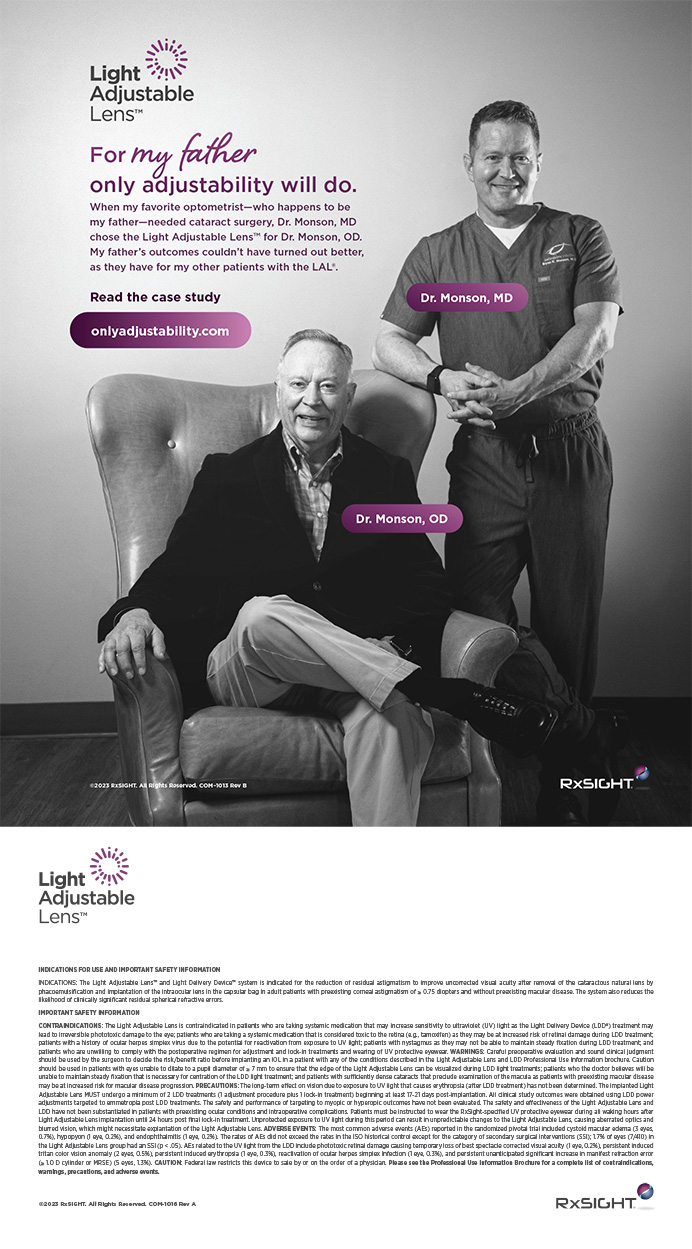
Throughout my whole life, I never wore spectacles or contacts. I was -2.50 +2.00 @ 90° OD, and I just walked around my life like that. I had halfway decent distance vision with my spherical equivalent, so I could drive and perform other day-to-day tasks comfortably, and I got used to my vision as it was. I squinted and accommodated my way through life. And because I could enter my prescription into the operating microscope during surgery, I was able to perform surgery without correction, too.
CHOOSING LASER VISION CORRECTION
It wasn’t until I got involved with teaching, speaking, and consulting that I began to notice how poor my vision was. After presentations at the podium, I would frequently get comments from friends and colleagues, saying that I was squinting a lot on stage. I couldn’t even read the confidence monitor from the stage. At this point I realized that, if I was going to continue speaking and teaching about vision correction and cataract surgery, it would be silly for me to continue being unable to read my notes on the subject.
What Convinced Me
What ultimately convinced me to get LASIK was that we started seeing superhuman visual results with great frequency when we switched to the iDesign 2.0 Refractive Studio (Johnson & Johnson Vision). It’s a surprise to me now when a patient has only 20/20 visual acuity postoperatively. Patient outcomes after LASIK in our practice are more commonly better than 20/20 these days: usually 20/15, sometimes 20/10.
When those kinds of visual outcomes became the norm in our practice and I saw how happy my patients were, I decided to go for it myself. I wanted to be able to actually see what I was looking at while teaching, and I felt that it would be silly for me to give a talk on laser vision correction while wearing glasses.
Additionally, driving at night was becoming more difficult. I have young children, so I wanted to make sure my vision was optimized for safety reasons, too. I wanted to feel confident and safe driving my own and my friends’ children.
My Procedure
After LASIK, I am now plano, and I see better than I ever thought I would. It was a strange experience to go straight from never wearing correction to LASIK. The adjustment experience was different than it is for someone who is already accustomed to good vision using corrective methods.
My father, Charles Williamson, MD, performed my procedure, and it was streamed on Facebook Live in its entirety (click here to watch). The video has since been viewed tens of thousands of times.
I think that, for patients who have been considering LASIK, seeing a surgeon—their own or any other ophthalmic surgeon—undergo this treatment goes a long way in helping to ease their minds.
THE IMPACT OF LASIK
The benefits that LASIK has had on my life are immeasurable. I have caught myself just staring at things. I sit on my front porch drinking coffee with my wife and stare out at the world that I can now see clearly. I live in southern Louisiana, and we have beautiful oak trees that drape our front yard. I lose myself now, just watching the birds, the squirrels, the leaves of the trees. It sounds cheesy, but it’s true.
I had never had corrected vision, so this has been truly transformational for me. I feel safer on the road, as I am now more comfortable driving at night, and I am undoubtedly a safer driver now that I can see road signs clearly.
Socially, it’s nice to be able to recognize people’s faces from a distance. Before LASIK, if I was at a Louisiana State University football game or other large social event, I wouldn’t recognize people until I was right up close to them. I realized people must have thought I was being rude by not recognizing them. Now I can recognize people from far away.
Having LASIK has benefited me as a surgeon as well. My operating days have become easier. In my high-volume cataract surgery practice, I sometimes do 30 or 35 cataract surgeries per day, and, after operating for 7 hours straight, I used to almost always have a headache at the end of the day from constantly accommodating. Now I don’t experience those headaches.
Having had LASIK also helps me be a better patient ambassador. The first couple of hours after a LASIK procedure can be uncomfortable for patients. Most people don’t talk about it because, by that same evening, and certainly by the next morning, there’s no pain. In those first couple of hours, however, patients may experience a burning sensation or tearing.
Now I can speak to those postoperative symptoms from first-hand experience. I can set patients up to expect this discomfort in the hours after surgery.
In treating and engaging with patients, having LASIK has enabled me to be a better communicator. It’s also empowered me to be more critical when considering low amounts of refractive error. After my LASIK procedure, I could tell that the refraction in one of my eyes was about -0.75 or -0.50 D and the other eye was plano. It was very clear to me that the plano eye was seeing better. Even though I was able to read the 20/20 line with my -0.50 D eye, I could tell that the vision in my plano eye was much sharper.
I can also relate to patients regarding any minor symptoms they have postoperatively. If a patient notes slightly foggy vision during a day 1 postoperative visit, I can tell him or her that I experienced that as well. I tell the patient why it is happening, that it doesn’t last, and that it is normal. It helps patients when there is someone who’s gone through the procedure already, especially if that person is the surgeon who will be operating on them.
Before my LASIK, if a patient was, say, -6.00 D preoperatively and I improved that to -0.50 D with LASIK, and that patient was not satisfied, I might feel frustrated or exasperated with him or her. But now I know that any small difference can be like night and day. I no longer just shrug off unsatisfied patients, even with low levels of residual refractive error. I am more sympathetic and empathetic toward patients who have residual refractive errors.
If a patient has a -0.50 D residual error, and a contact lens trial shows that small correction makes all the difference in the world to that patient, I’ll lift the flap and retreat that eye. Before I had LASIK, I might have shrugged that dissatisfied patient off because his or her visual outcome was so much better than it was before LASIK, and the residual error so small. Now I am more willing to perform enhancements for low levels of refractive error.
A CHANGE FOR THE BETTER
Undergoing LASIK has benefited both my personal and professional life in many ways. I am more comfortable performing the day-to-day activities of my life, and I have become a better communicator and ambassador for my patients.




